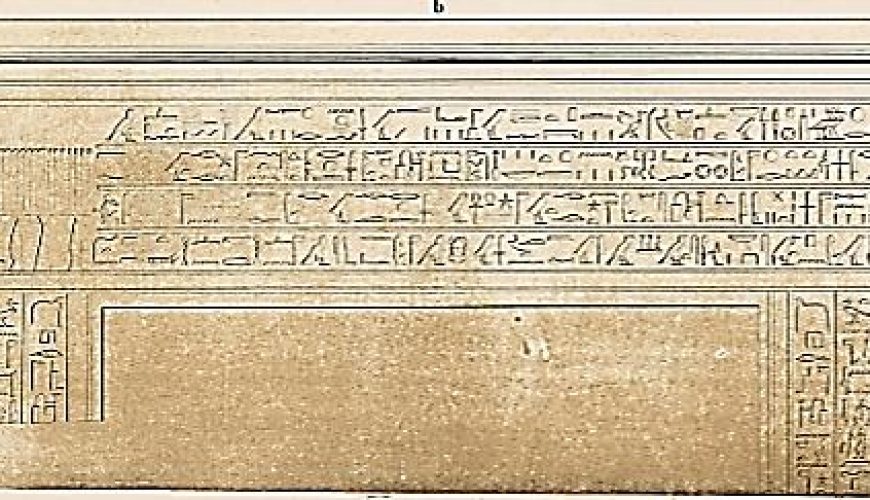A rare example of a non-royal woman who breaks the bureaucracy in ancient Egypt
Titles and what they refer to as roles and status in ancient Egypt represent a problem for the contemporary researcher, especially those related to women, which are often referred to as mere honorary and ceremonial titles that do not involve any real responsibilities.
As one of the most important and famous professions in the ancient Egyptian civilization, the writer’s profession, which is everyone’s mind, was associated with men and not women overlook us. This profession entails an arduous journey in learning to read and write, assuming a central and vital role in the ancient Egyptian administration.
But as was the custom of the ancient Egyptian civilization, and as was the custom of Egyptian women in ancient Egypt; To find something that fascinates us, as very few succeeded in breaking this rule and deviating from the norm by bearing the title of writer. Where the most important and controversial example comes in the late-era, specifically in the twenty-sixth dynasty, where a huge tomb was discovered in 1820 and was recorded in 1840 in the area of South Al-Asasif, located in front of Deir el-Bahari on the western mainland in Luxor, for a woman called “Art Aro” bearing the title of a writer with more than one inscription inside the cemetery, this title aroused a lot of controversies and raised many questions about this woman and her identity, for example, but not limited to:
How did this lady receive the basics of a writer’s profession, which seems impossible to give its holder an honour?!
How did you assume this profession in the divine institution of Amun’s wife in Thebes?!
Does her profession involve actual and real responsibilities?!
Did you get what the male writer got from the privileges?!
To answer these questions, we must look deeply into ancient Egyptian society; Although women were excluded from the government structure; This did not mean that they did not learn to read and write at all; Especially in the case of queens and divine wives who assumed political roles, as well as princesses in the royal court, as well as priestesses. There is even more support for the hadith since the deity concerned with writing in ancient Egypt was the female “Seshat”, the consort of the god “Thoth,” the Lord of wisdom and knowledge in ancient Egypt.
Therefore, we must assume that Art Arrow learned to write and read, and even the basics of the writer’s profession, even if it was indirectly from a member of her family who went to school to receive direct education.
As for the second question, Mrs. “Art Aru” is the daughter of one of the “Thana” families, and her transfer and assumption of the position coincided with the transfer of the daughter of King “Psamtik I” “Nate Iqrt” to begin her profession as an adopted daughter in the position of the divine wife of “Amon” in Thebes. From Then she assumed the position of the divine wife of “Amon”, which confirms that the choice of “Art Arrow” is only for the skills and capabilities of “Art Arrow” in taking these new positions as a writer and chief servant of the divine institution in Thebes and that it is unreasonable to grant “Art Arrow” Arrow this position in an honorary capacity, even if we did not find any writings or representations of the scribe in her tomb inscriptions; That body we are accustomed to for the male writer, which may justify that this session of the male writer is not entirely appropriate for a woman.
Regarding the third question, “Art Aro” was a woman with great privileges stemming from her assumption of great positions and not stemming from her being the wife of a minister and the mother of a minister because; Even if that were the case, we would have found that she was buried with her husband or son, but her husband was buried in the cemetery of his ancestors in Abydos, where their original homeland is, while her son tried to rape the tomb of the first priest “Karachamon” adjacent to his mother’s tomb because of his strong desire to be buried next to her.
As for the franchisor herself, Art Aro resigned with a large cemetery bearing her inscriptions. He even represented her as a main figure in the cemetery, in the form of young kings and queens and individual poses. This confirms that this woman enjoyed a great position that seems to be parallel to the position of the most important position in this institution at that time, which is; The position of the Great Director of the House of the Divine Wife, which is confirmed by the selection of the location of her tomb within the area of Al-Asasif, where the great administrators were buried.
After answering some questions, we must emphasize that Art Arrow is a non-royal woman who enjoyed royal privileges, and what is even worse is that she broke the pattern of the Egyptian bureaucracy, which has long been restricted to men rather than women, even if this was not acceptable in Egyptian society, this matter which was not The ruling queens such as Sobekneferu and Hatshepsut survived, and it seems that the explanation of this increasing power of women, and the growth in independence from husbands and sons, was linked to the growth of the power of the divine institution of Amun’s wife in later times.


Comment (0)